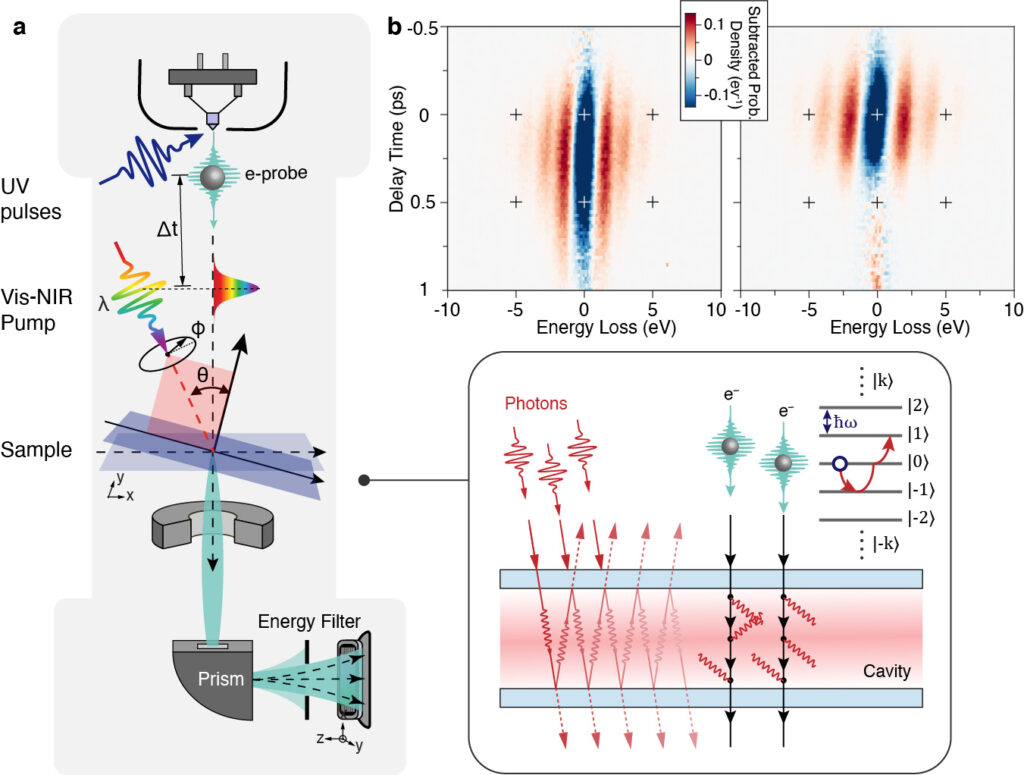Nature: Coherent interaction between free electrons and a photonic cavity
The investigation of interactions between bound electron systems and photonic cavities, also known as cavity quantum electrodynamics (CQED), has been paramount for realizing new physical effects (e.g. 2012 Nobel Prize for Physics) and applying them for quantum technologies. However, all bound electron systems (such as atoms, quantum dots, and quantum circuits) are limited by fixed energy states, spectral range, and selection rules.
The photo-excited free electrons from the electron gun in our UTEM can be considered as quantum free-electron wavepackets. Such photo-excited free electron wavepackets have tunable energy states, wide spectral range, and unlimited transition rules. Can we use these quantum free-electron wavepackets to interact with the photonic cavity instead of the bound electron systems and thus open more possibilities for new physics?
Our work reports the first photonic cavity effect realized with free electrons, exploiting the strong interaction strength and the duration of the confinement of light in high-Q Bloch modes inside a photonic crystal. We directly observed the decay of the confined photons of the cavity mode. The high-Q cavity was also used to enhance the strength of the electron–photon interaction by about 30 times comparing to previous reports, with a record low pulse energy down to 100 pJ. Additionally, we showed a powerful near-field optical microscopy based on our UTEM, which in many aspects achieves the best capabilities in nearfield optical microscopy. With this technique, we obtained the Bloch mode images showing how the light was trapped inside a photonic crystal for the first time and measured its photonic bandstructure. We hope to start using the technique developed in this paper to nurture new experimental projects on materials coming from different collaborations.

Figure 1 | Experimental scheme for cavity quantum electrodynamics (CQED) with quantized free electrons in the ultrafast transmission electron microscope (UTEM). a, The UTEM setup, offering five degrees of freedom to measure the electron–cavity interactions. We can image the electrons with or without energy-filtering. Inset: schematic image showing the quantized interaction of free electrons with cavity photons, where the electrons are dressed into an infinite quantum energy ladder equally spaced by the photon energy ℏω. b, Time-resolved difference EELS map after subtracting the zero-loss electrons, showing the difference between high-Q and low-Q photonic modes. The high-Q map (left) is elongated and time-asymmetric in contrast with the shorter and time-symmetric low-Q map (right).
§ Our research is selected for Research Highlights in Nature Reviews Physics and featured in phys.org. We also thank the following media outlets to highlight our results:
- Israel, lbscience.org, שיר של אור וחומר
- Israel, ynet.co.il, לראשונה תועדה זרימת אור בתוך גביש פוטוני
- Israel, haaretz.co.il, איך נראה אור ממש מקרוב? ״המיקרוסקופ הקוונטי״ מתעד תופעות שטרם נראו
- Japan, JEOL, One-of-a-kind Microscope Enables Breakthrough in Quantum Science.
- Israel, timeofisrael.com, Groundbreaking Israeli microscope can change the face of tech — scientists
- 中国光学,Nature:记录光子流动的新型量子显微镜
- 澎湃新闻,利用全新量子显微镜,科学家首次观察到纳米光晶体内光的动态

